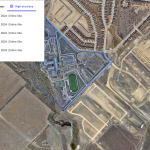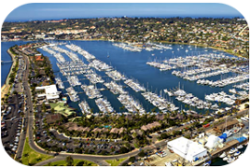Q: How can a GPS receiver or MEMS (micro-electro-mechanical systems) inertial sensor assembly sense a host platform’s orientation? How can these sensor technologies be combined together?
Q: How can a GPS receiver or MEMS (micro-electro-mechanical systems) inertial sensor assembly sense a host platform’s orientation? How can these sensor technologies be combined together?
A: Many applications need information on the orientation or attitude of the host platform, such as in the case of automatic flight control, airborne mapping or imaging, antenna pointing control, and so on. The attitude can be mathematically represented by any of the following set of parameters: a quaternion, direction cosine matrix, Gibbs vector, or Euler angles. All of these representations are mathematically equivalent and can be transformed from one to another.
Attitude determination from GPS
Two or more independent GPS receivers with L1 carrier phase output capability form the basis of an attitude determination (AD) system. However, most commercial AD products use a common reference clock to convert the received GPS RF signals into the intermediate frequency (IF). The IF signals are then fed into the tracking loops to demodulate GPS data and generate observations such as pseudorange, Doppler, and carrier phase.
One benefit of using a common clock reference is that the clock error is a common one for carrier phase measurements from all antennas, and thus it can be removed by forming single-differences between antennas. This is crucial for deriving the attitude solution from the inter-antenna single-differenced carrier phase.
GPS AD algorithms using inter-antenna single-differences can generally be divided into three functional categories: the line bias solution, integer ambiguity resolution, and the attitude solution, which will be discussed later. However, if double-difference measurements are used, the line bias solution is no longer necessary.
Line biases are mainly caused by the differences in cable lengths between antennas and receivers. They are usually treated as constant quantities and calibrated by a procedure prior to operating the GPS attitude determination receiver. They can also be treated as components of the state vector of the system, and hence estimated along with other states.
Because a GPS receiver can measure only the fractional part of the carrier phase, the integer number of wavelengths between antenna and satellite is unknown. Numerous approaches have been developed to resolve the integer ambiguity problem, including motion-based methods, search-based methods, or a combination of both.
(For the rest of Yong Li’s answer to this question, please download the complete article using the PDF link above.)
Q: What are the differences between the coherent and non-coherent versions of deep integration of combined inertial navigation and GNSS systems (INS/GNSS)?
A: Deep (or ultra-tightly-coupled) INS/GNSS integration differs from conventional integration architectures, such as tightly coupled ones, in that the GNSS signal tracking and INS/GNSS integration functions are combined into a single estimation algorithm. This provides improved GNSS signal-tracking performance in poor signal-to-noise environments resulting from signal attenuation, incidental interference, or deliberate jamming.
Figure 1 (to view all figures and tables, please download the PDF version of this story using the link at the top of this article) shows a closed-loop deep, or ultra-tightly-coupled (UTC), INS/GNSS integration architecture. The GNSS receiver performs front-end conditioning and sampling of the incoming GNSS signals and then correlates them with internally generated reference signals. The accumulated correlator outputs, known as Is and Qs, are output from the GNSS receiver to the INS/GNSS integration algorithm Kalman filter.
The GNSS receiver inputs numerically controlled oscillator (NCO) commands that control the reference signals, keeping each code phase and carrier frequency aligned with the corresponding incoming GNSS signal. The NCO commands are generated using the (corrected) inertial navigation solution, satellite constellation ephemeris parameters, satellite and receiver clock error estimates, and ionosphere and troposphere propagation delay estimates. Finally, the Kalman filter corrects the inertial navigation solution to form the integrated navigation solution.
Deep INS/GNSS integration algorithms may be divided into two categories, coherent and non-coherent. Coherent algorithms input the GNSS accumulated correlator outputs, the Is and Qs, directly to a Kalman filter as measur ements. Non-coherent algorithms first pass the Is and Qs through code and carrier discriminator functions, similar to those used in conventional GNSS signal tracking. Coherent deep integration may be further divided into centralized and federated approaches.
Figure 2 shows the data flow between the GNSS receiver and integration algorithm for coherent deep integration with a centralized Kalman filter. For the legacy GPS signals, the minimum rate at which Is and Qs may be generated is the navigation-data-message rate of 50 Hz due to the navigation message data bits. Thus, inputting the Is and Qs directly to the Kalman filter requires it to be iterated at 50 Hz or more.
For the new data-free signals (e.g., pilot components of GPS L2C and Galileo L1, etc.), or where navigation-data wipe-off is implemented, other constraints apply. The measurement vector is also large, with the number of components equal to six times the number of signals tracked (assuming three complex correlators per signal – early, prompt, and late).
(For the rest of Paul Groves’s answer to this question, please download the complete article using the PDF link above.)
Acknowledgment
QinetiQ’s deep integration research and development was funded by the United Kingdom Ministry of Defence.
Additional Resources
Groves, P. D., and C. J. Mather and A. A. Macaulay, “Demonstration of non-coherent deep INS/GPS integration for optimized signal-to-noise performance,” Proceedings ION GNSS 2007, September 2007.
Groves, P.D., Principles of GNSS, Inertial and Multisensor Integrated Navigation Systems, Artech House, January 2008.






